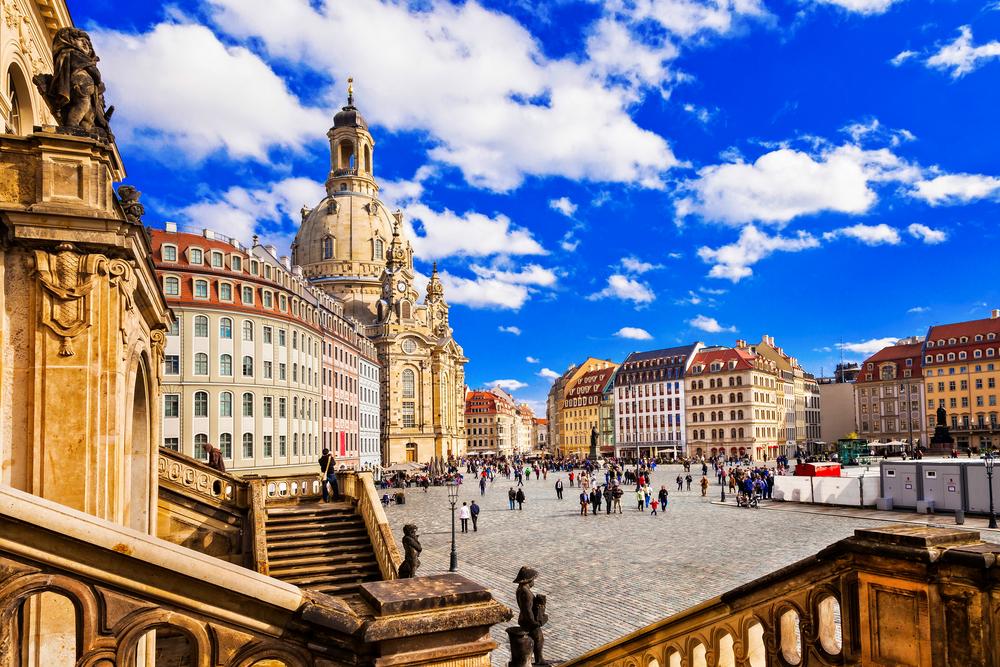In a wide valley basin of the upper Elbe lies the worldwide fame Dresden. Travellers feel transported to more southern climes when they follow the Elbe downstream. Vineyard terraces are staggered on the slopes and well-kept estates peek out from behind fruit trees. “Florence on the Elbe” is the decorative epithet of a city that looks back on a long and eventful history. Surrounded by a lovely scenery, Dresden inspires with countless treasures in the Mediterranean-looking Elbe Valley. When Brühl’s Terrace, Palace, Court Church, Semper Opera House and Augustus Bridge are reflected in the Elbe, a moving panorama is offered. Three associations are associated with Dresden: the rise of the city during its heyday under Augustus the Strong, the destruction of Dresden in the night of the bombing in 1945 and finally the encouraging reconstruction, especially after the unification of the two states.
In the triad of art, history and nature
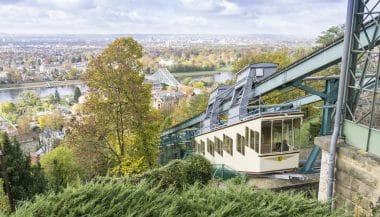
Dresden. Risen from ruins – rubble stones in new splendour
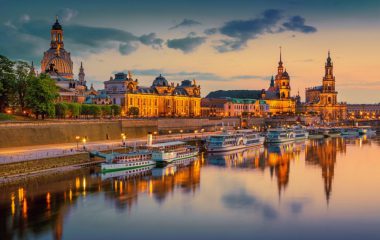
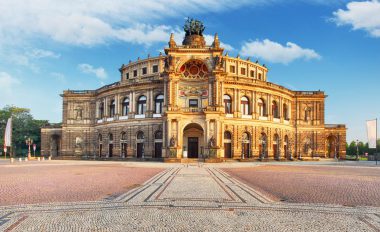
The Zwinger – Masterpiece of World Culture
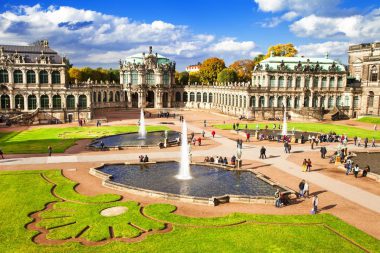
Dresden – proud Saxon metropolis with works of art of immeasurable value
Anyone who visits the city today needs days to pay tribute to the museums. The Zwinger houses several museums and collections.
- The Wallpavillon is the jewel of the Zwinger. At the apex of the westward-facing arched gallery, the expressiveness of the figural splendour created by Permoser reaches its climax. Behind the pavilion is the wonderfully playful Nymphenbad.
- To the right of the Kronentor, the Zoological Museum houses the skeleton of a manatee that became extinct 300 years ago.
- In the gallery half to the left of the Kronentor you can admire the porcelain collectionof Augustus the Strong, founded in 1717.
- The largest German collection of globes and the oldest calculating machine in the world are worth a visit to the Mathematical and Physical Salon.
- In the “Old Masters” picture gallery, important works of European painting from the 15th to 18th centuries, including Raphael’s “Sistine Madonna”, can be seen.
- The Armoury houses the magnificent weapon collection of the Saxon electors from the 16th to 17th centuries.
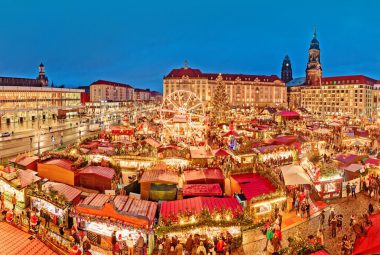
This is where the heart of historic Dresden beats and the magnificent buildings shake hands. The Semperoper dominates the area. Not far away are the castle and court church. From the 110-metre-high Hausmannsturm of the castle, you can enjoy a magnificent view of the Theaterplatz. The Old Town Guard and the Taschenberg Palace complete the ensemble. Past the Hofkirche, you reach the “Balcony of Europe”. The Brühl Terrace, which stretches over the banks of the Elbe on the remains of Dresden’s fortifications, is the only surviving witness to the mighty fortifications from the 16th century. Visitors from all continents stroll here and let their eyes wander over the flowing Elbe with its imposing steamships to the other side of the Elbe with Dresden’s Neustadt. On Brühl’s Terrace, in the Albertinum, art lovers can look forward to the “New Masters” picture gallery with works of art from the Romantic period to the present day. The Green Vault, just a few metres from the Albertinum, is a crowd-puller – a sparkling casket and the richest treasure chamber in the world. From the Albertinum it is not far to Neumarkt, which was probably the most picturesque square in Dresden until February 1945. The Neumarkt is dominated by the rebuilt Frauenkirche. With its famous stone dome, it shapes the city skyline. East of the old town is the Great Garden from 1676 with an open-air stage, puppet theatre, zoo, botanical garden and a park theatre. The centre is the garden palace with the palace pond and the cavalier houses. The sculptures, borrowed from Greek legends, are particularly impressive. From the old town, you can reach the Neustädter Markt via the Augustus Bridge, dominated by the equestrian statue of Augustus the Strong. Dresden’s most famous bridge – the “Blue Wonder” – leads into an oasis of upper-class architecture. The mighty iron construction was built between 1891 and 1893 and connects the towns of Löschwitz and Blasewitz. A fantastic panorama lies at the feet of those who take the suspension railway up to the Oberloschwitz district. Also worth seeing: the German Hygiene Museum with its enormous charisma and the “Transparent Factory”, proof of Dresden’s international appeal as a business location. If you can’t get enough of Dresden, you are welcome to take a look around. In the immediate vicinity, Radebeul – the place where Winnetou’s spiritual father died, Moritzburg Castle, the forest park with game reserve and, last but not least, the charming town of Stolpe, which is picturesquely situated on a basalt dome and shares the tragic fate of the Countess of Cosel, beckon.
Dresden: The 7 most important sights with map
1. The Frauenkirche
The Frauenkirche is one of Dresden’s most famous landmarks.
After its destruction in the Second World War, it was lovingly reconstructed and shines again today in its full glory.
The dome of the church offers a breathtaking view over the city.
2. Kennel
The Dresden Zwinger is a Baroque masterpiece and is home to several museums, including the Old Masters Picture Gallery and the Porcelain Collection.
The magnificent gardens and pavilions are a highlight for every visitor.
3. Semperoper
The Semperoper is a world-famous opera house and an architectural gem.
Visitors can enjoy a performance or join one of the many guided tours to learn more about the history and architecture of the building.
4. Residential Palace
The Dresden Royal Palace is a historic palace that houses an impressive collection of art treasures, including the Green Vault, one of the richest treasure chambers in Europe.
5. Brühl’s Terrace
The Brühlsche Terrasse, also known as the “Balcony of Europe”, offers a beautiful view of the Elbe and the historic old town.
It is a popular place for walks and a must-see for any visitor.
6. Procession of Princes
The Procession of Princes is the largest porcelain painting in the world and shows the history of the Saxon rulers in impressive pictures.
It is located on the outer wall of the Stallhof in the Dresden Residential Palace.
7. Blue Wonder
The Blue Wonder, a bridge over the Elbe River, is a technical masterpiece and offers great views of the river landscape.
It connects the districts of Blasewitz and Loschwitz and is a popular place for photographers.
The 5 most important museums in Dresden
1. Old Masters Picture Gallery
The Old Masters Picture Gallery in the Zwinger displays an impressive collection of European artwork, including masterpieces by Raphael, Vermeer and Rembrandt. Address: Theaterplatz 1, 01067 Dresden Opening hours: Tuesday – Sunday 10:00 am – 6:00 pm Admission: 14 EUR
2. Green Vault
The Green Vault in the Royal Palace is one of the richest treasure chambers in Europe and displays magnificent works of art made of gold, silver and precious stones. Address: Taschenberg 2, 01067 Dresden Opening hours: Daily 10:00 a.m. – 6:00 p.m. Admission: 12 EUR
3. German Hygiene Museum
The Deutsches Hygiene-Museum offers an interactive exhibition about the human body and health.
It is particularly interesting for families and school classes. Address: Lingnerplatz 1, 01069 Dresden Opening hours: Tuesday – Sunday 10:00 am – 6:00 pm Admission: 10 EUR
4. Military History Museum of the German Armed Forces
This museum offers a comprehensive overview of German military history and displays numerous exhibits, from uniforms to aircraft. Address: Olbrichtplatz 2, 01099 Dresden Opening hours: Wednesday – Monday 10:00 am – 6:00 pm (Monday until 9:00 pm) Admission: 5 EUR
5. Dresden Transport Museum
The Dresden Transport Museum shows the development of means of transport, from historic locomotives to modern cars and airplanes. Address: Augustusstraße 1, 01067 Dresden
Opening hours: Tuesday – Sunday 10:00 am – 6:00 pm
Admission: 9 EUR
Weather in Dresden
Excursion destinations outside Dresden
Saxon Switzerland
Saxon Switzerland is a stunning natural area located about 30 kilometers southeast of Dresden.
With its bizarre rock formations, deep gorges and extensive forests, the region is a paradise for hikers and climbers.
Particularly impressive is the Bastei, a rock formation with a historic bridge that offers spectacular views of the Elbe Valley.
Moritzburg Castle
Located about 15 kilometers northwest of Dresden, Moritzburg Castle is a magnificent baroque palace built on an artificial island in a pond.
The castle is known for its magnificent interior and the surrounding parks.
Meissen
Meissen, only 25 kilometers from Dresden, is the home of the world-famous Meissen porcelain.
The old town with its cathedral and the Albrechtsburg is worth a visit, as is the porcelain manufactory, where visitors can learn more about the production of the “white gold”.
Where to stay in Dresden
Luxury hotel: Hotel Taschenbergpalais Kempinski
The Taschenbergpalais Kempinski is one of the most luxurious hotels in Dresden, offering first-class service, elegant rooms and a central location close to the Semper Opera House and the Zwinger.
4-star hotel: Hyperion Hotel Dresden am Schloss
This modern hotel offers stylish rooms and suites, as well as a spa.
It is centrally located near the Royal Palace and is ideal for business travellers and tourists.
3-star hotel: Motel One Dresden am Zwinger
The Motel One offers excellent value for money with modern, comfortable rooms and a central location right next to the Zwinger.
Budget Hotel: A&O Dresden Central Station
For travelers on a budget, A&O Dresden offers affordable accommodation near the main train station.
There are both private rooms and shared rooms.
Popular Restaurants in Dresden
Kastenmeiers
Kastenmeiers is known for its excellent fish and seafood cuisine.
Located in the Kurländer Palais, it offers an elegant atmosphere with an innovative menu.
Powder Tower at the Frauenkirche
In the Powder Tower, you can experience traditional Saxon cuisine in historic vaults.
The restaurant offers a unique atmosphere and is popular with locals and tourists alike.
FAQ: Important questions about Dresden
When is the best time to travel to Dresden?
Dresden is a worthwhile destination all year round.
Spring and summer are ideal for city sightseeing and outdoor activities, while winter offers the famous Striezelmarkt, one of the oldest Christmas markets in Germany.
What is the best way to get around Dresden?
Dresden has a well-developed network of public transport, including trams and buses.
Bicycles can also be rented to explore the city.
What currency is used in Dresden?
In Dresden, the Euro (€) is used.
Credit cards are accepted in most shops and restaurants, but it is advisable to have some cash with you for smaller purchases.
Is there a City Card in Dresden?
Yes, the Dresden City Card offers free admission to many attractions and unlimited use of public transport.
What are typical souvenirs from Dresden?
Typical souvenirs from Dresden are Meissen porcelain, Dresdner Stollen (a traditional Christmas pastry) and handicrafts from the region.
Bibliography
- Information about sights and museums: City of Dresden
- Google Maps
Article updated on August 15, 2024


